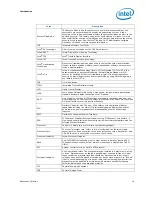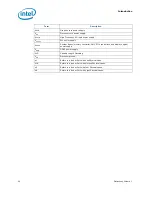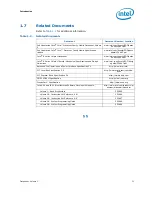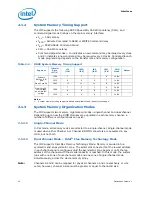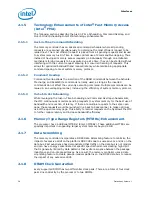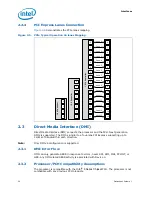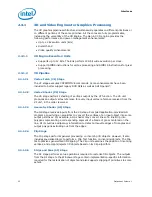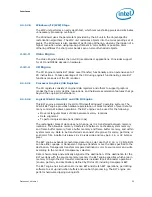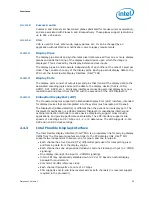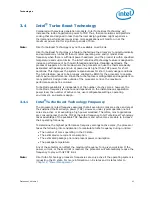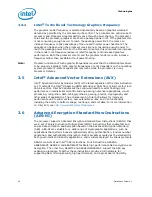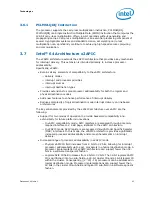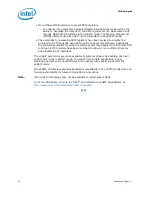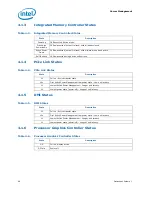
Datasheet, Volume 1
33
Interfaces
2.4.1.2.6
Windower/IZ (WIZ) Stage
The WIZ unit performs an early depth test, which removes failing pixels and eliminates
unnecessary processing overhead.
The Windower uses the parameters provided by the SF unit in the object-specific
rasterization algorithms. The WIZ unit rasterizes objects into the corresponding set of
pixels. The Windower is also capable of performing dithering, whereby the illusion of a
higher resolution when using low-bpp channels in color buffers is possible. Color
dithering diffuses the sharp color bands seen on smooth-shaded objects.
2.4.1.3
Video Engine
The Video Engine handles the non-3D (media/video) applications. It includes support
for VLD and MPEG2 decode in hardware.
2.4.1.4
2D Engine
The 2D Engine contains BLT (Block Level Transfer) functionality and an extensive set of
2D instructions. To take advantage of the 3D during engine’s functionality, some BLT
functions make use of the 3D renderer.
2.4.1.4.1
Processor Graphics VGA Registers
The 2D registers consists of original VGA registers and others to support graphics
modes that have color depths, resolutions, and hardware acceleration features that go
beyond the original VGA standard.
2.4.1.4.2
Logical 128-Bit Fixed BLT and 256 Fill Engine
This BLT engine accelerates the GUI of Microsoft Windows* operating systems. The
128-bit BLT engine provides hardware acceleration of block transfers of pixel data for
many common Windows operations. The BLT engine can be used for the following:
• Move rectangular blocks of data between memory locations
• Data alignment
• To perform logical operations (raster ops)
The rectangular block of data does not change, as it is transferred between memory
locations. The allowable memory transfers are between: cacheable system memory
and frame buffer memory, frame buffer memory and frame buffer memory, and within
system memory. Data to be transferred can consist of regions of memory, patterns, or
solid color fills. A pattern is always 8 x 8 pixels wide and may be 8, 16, or 32 bits per
pixel.
The BLT engine expands monochrome data into a color depth of 8, 16, or 32 bits. BLTs
can be either opaque or transparent. Opaque transfers move the data specified to the
destination. Transparent transfers compare destination color to source color and write
according to the mode of transparency selected.
Data is horizontally and vertically aligned at the destination. If the destination for the
BLT overlaps with the source memory location, the BLT engine specifies which area in
memory to begin the BLT transfer. Hardware is included for all 256 raster operations
(source, pattern, and destination) defined by Microsoft, including transparent BLT.
The BLT engine has instructions to invoke BLT and stretch BLT operations, permitting
software to set up instruction buffers and use batch processing. The BLT engine can
perform hardware clipping during BLTs.
Содержание 2ND GENERATION CORE PROCESSOR FAMILY DESKTOP - VOLUME 1 01-2011
Страница 10: ...10 Datasheet Volume 1 Revision History Revision Number Description Date 001 Initial Release January 2011 ...
Страница 22: ...Introduction 22 Datasheet Volume 1 ...
Страница 62: ...Power Management 62 Datasheet Volume 1 ...
Страница 86: ...Signal Description 86 Datasheet Volume 1 ...
Страница 106: ...Electrical Specifications 106 Datasheet Volume 1 ...
Страница 172: ...DDR Data Swizzling 172 Datasheet Volume 1 ...

